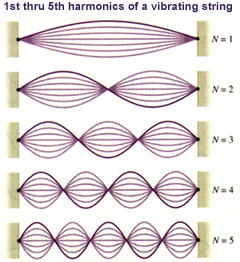Republished by Blog Post Promoter
Vibrational Basics
A note is a single tone, pitch or frequency.
A doubling of the frequency of any note produces a higher note with the same pitch, as in middle C and high C on a piano. this is known as an Octave.
Octaves go on forever above and below our musical scale, they are simply halving’s or doublings of frequency. One drum beat per second is what middle C sounds like 8 Octaves down. By some strange coincidence, there are 50 octaves from a beat of one per second (the lowest range of the human heartbeat) to the frequency of visible light. A beat or Rhythm is a couple octaves below what we hear as music and light and color are a few dozen octaves above music.
A chord is any two notes or pitches played simultaneously.
All chords produce certain sounds which are unique because whenever two notes are played together, a third note or beat is also heard. this third note is not inherent in either note but only as a synergetic consequence of their unity, constructed in the brain.
Two notes played together produce a third, three notes played together produce three other notes from the various combinations of two notes, four notes produces six new tones, five produces eleven, and so on. The notes may not always sound like musical pitches because their frequencies may be below 16 cycles per second, the minimum frequency that sounds like a note to our ears.
The secondary notes (children, or 2nd level ‘iteration’ (repeating sequence) of the first notes) interact with one another and create tertiary notes (grandchildren or 3rd level iterations) and so on, to infinity, so that the combinations become rather astounding.
The Harmonic Series
The notes within any note are the iteration of the harmonic series, wherein if we could hear ‘down’ into it, any note contains all other notes by way of this harmonic subdivision. But each new generation has less volume than the previous and fades into the background after so many. Even so, a part of you can sense the presence of nearly subliminal notes. It is even possible that the brain picks up on the pattern and carries the iterations out farther than hearing actually allows.
Pluck a string and you get a complex wave composed of all the harmonics of the root note. The different standing waves corresponding to different fractions are called harmonics.
The first five harmonics on a vibrating string are shown on the right.
The same Harmonic (father, children, grandchildren) subdivisioning that happens in musical notes and chords happens in any situation where vibrational events are intersecting, including atomic vibration. The wave interactions and phase cancellations that happen in a musical chord are the very same ones that govern
• ways which molecules will bond or repel,
• which waves on the ocean will pass through others, and
• what gravitational orbits the planets fall into – among other things.
Learn more about Harmonic Resonance here: http://www.miqel.com/jazz_music_heart/vibrational-truth.html
